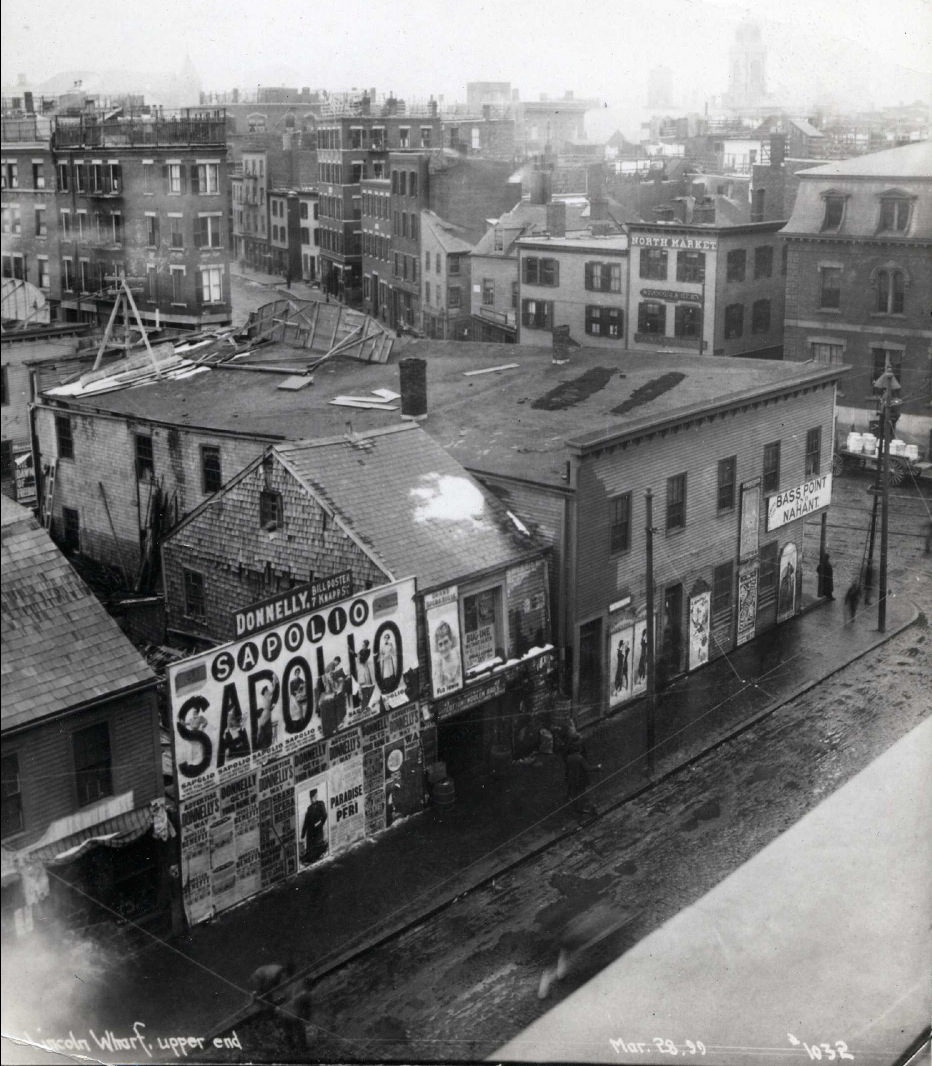From the City of Boston Archives, we find this 1899 photo on the site of what is now Lincoln Wharf at the intersection of Commercial and Battery Streets. Looking inward is North Street and I believe that is the bell tower of St. Mary’s Church St. Stephen’s Church in the upper right. (Corrected: As pointed out in the comments, St. Stephen’s Church was significantly higher at the time of this photograph than it is today.)

10 Replies to “1899 North End Waterfront Photo”
Comments are closed.




Yes u are 100% right
The church is St. Stephen’s on Hanover St. Cardinal Cushing agreed to pay and have the church lowered back to the way Charles Bulfinch originally designed it. In this photo it still had a lower church and was ten feet taller than it is today. I remember Cushing was aghast at the cost but it was the right thing to do.
Could that be St. Mary’s barely visible in the upper left corner — I agree that it is St. Stephen’s in the upper right corner.
What a great photo.
I think it is St. Mary’s. The twin spires had burned down by the time this photo was taken. It was a beautiful church, I was an altar boy there.
Geat photo! And yes, St Stephen’s was lowered by Cardinal Cushing.
Thanks Nick, Pat and Kathleen. I corrected the text in the original post to reflect that it is St. Stephen’s. I appreciate the help!
That restoration project was nicknamed “Cushing’s Folly”. The Cardinal was, indeed, shocked at the high cost and vowed never to invest in “historic restoration” again. However, as a native North Ender, I believe it is safe to say that the decision to restore
St. Stephen’s back to the original Charles Bulfinch design demonstrated incredible foresight on the part of Richard Cardinal Cushing and the Archdiocese of Boston.
Just think if some of those building/houses/apartments could talk? What stories they could tell. Fun looking back.
The houses are speaking to us and telling their story. There are so many interesting things about this photo. The cobblestone streets, some of which are still buried under the asphalt, the rail road tracks on Commercial St. from the Union Freight RR, the sign advertising Bass Point/Nahant because ferries were still the best way to the North and South Shores. When I was a teenager we could still take a ferry from Rowe’s Wharf to Nantasket Beach. Notice that almost every roof has a wooden deck. In the days before air conditioning we used to sleep on the roof in the summer and it was a great place for clothes lines. The beautiful granite building on the right side of the photo which is now gone. Most of the buildings were still wooden and fires were common. Great photo, Matt.
Hey Dad, there’s a second photo from this era, taken from the opposite side of the intersection of Commercial and Battery at: http://www.flickr.com/photos/cityofbostonarchives/8273235814/in/photostream/. You can see the freight/trolley tracks that you describe in your earlier posting (so is this before the elevated was built – the one that got partially warped in the Great Molasses Explosion of ’19?) as well as more ferry/shipping companies on the premises before the Lincoln power plant was built. It’s funny to see horses and wagons, but you said that there were a few around even when you were a kid.
One thing I don’t get is that another photo on the same city site, also from ’99, shows the twin towers of St. Mary’s still standing (http://www.flickr.com/photos/cityofbostonarchives/8273235430/in/photostream/). When were they removed/burnt down? The view is from the Charlestown bridge, so it must be St. Mary’s off Endicott. Perhaps the massive-church like structure that we’re seeing from the back in the original photo on the far left is Sacred Heart (seeing that we’re looking down North Street), and the second campanile is one of the other Hanover Street churches – the Baptist or Portuguese churches at the corner of N. Bennett? St. Leonard’s? Off the top of my head, I don’t think the Gothic-style “Cockrel” was still around.
I like this photo trivia series, North End Waterfront! In addition to the on-line digital photos, there are many in the North End Libray’s special collection of North End books and manuscripts (non-circulating). A friend of mine used these to research a property well back into the 1600’s, and that would not be an exceptional case for this area. Of course, he dug up the whole “brothel” bit, but what else would you expect in a district so close to the water?
Your attentive daughter Jessica